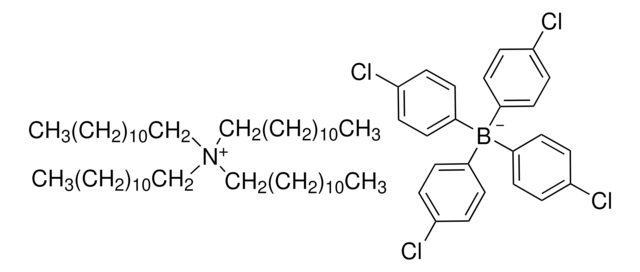60591
Potassium tetrakis(4-chlorophenyl)borate
Selectophore™, ≥98.0%
Sinónimos:
Tetrakis(4-chlorophenyl)boron potassium
About This Item
Productos recomendados
grade
for ion-selective electrodes
Quality Level
product line
Selectophore™
assay
≥98.0% (AT)
≥98.0%
form
solid
SMILES string
[K+].Clc1ccc(cc1)[B-](c2ccc(Cl)cc2)(c3ccc(Cl)cc3)c4ccc(Cl)cc4
InChI
1S/C24H16BCl4.K/c26-21-9-1-17(2-10-21)25(18-3-11-22(27)12-4-18,19-5-13-23(28)14-6-19)20-7-15-24(29)16-8-20;/h1-16H;/q-1;+1
InChI key
SAGICZRAKJSWLD-UHFFFAOYSA-N
¿Está buscando productos similares? Visita Guía de comparación de productos
General description
Application
Packaging
Legal Information
signalword
Danger
hcodes
Hazard Classifications
Acute Tox. 3 Oral
Storage Class
6.1C - Combustible acute toxic Cat.3 / toxic compounds or compounds which causing chronic effects
wgk_germany
WGK 3
flash_point_f
Not applicable
flash_point_c
Not applicable
ppe
dust mask type N95 (US), Eyeshields, Gloves
Elija entre una de las versiones más recientes:
¿Ya tiene este producto?
Encuentre la documentación para los productos que ha comprado recientemente en la Biblioteca de documentos.
Los clientes también vieron
Nuestro equipo de científicos tiene experiencia en todas las áreas de investigación: Ciencias de la vida, Ciencia de los materiales, Síntesis química, Cromatografía, Analítica y muchas otras.
Póngase en contacto con el Servicio técnico
![Sodium tetrakis[3,5-bis(trifluoromethyl)phenyl]borate Selectophore™](/deepweb/assets/sigmaaldrich/product/structures/251/439/7a621e74-bfd1-4a43-833c-09adfcc1e0b3/640/7a621e74-bfd1-4a43-833c-09adfcc1e0b3.png)


![Potassium tetrakis[3,5-bis(trifluoromethyl)phenyl]borate Selectophore™](/deepweb/assets/sigmaaldrich/product/structures/631/130/b5486f44-2e69-40d0-902f-dd71894a6add/640/b5486f44-2e69-40d0-902f-dd71894a6add.png)







